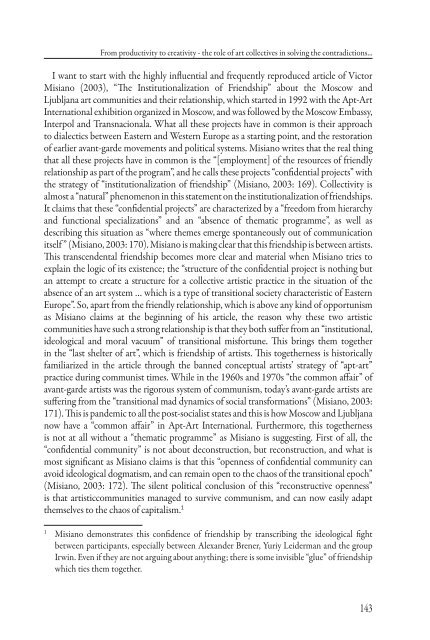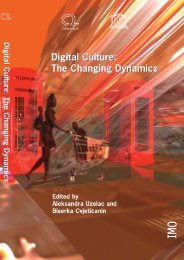free download in pdf format - Culturelink Network
free download in pdf format - Culturelink Network
free download in pdf format - Culturelink Network
You also want an ePaper? Increase the reach of your titles
YUMPU automatically turns print PDFs into web optimized ePapers that Google loves.
From productivity to creativity - the role of art collectives <strong>in</strong> solv<strong>in</strong>g the contradictions...<br />
I want to start with the highly <strong>in</strong>fl uential and frequently reproduced article of Victor<br />
Misiano (2003), “Th e Institutionalization of Friendship” about the Moscow and<br />
Ljubljana art communities and their relationship, which started <strong>in</strong> 1992 with the Apt-Art<br />
International exhibition organized <strong>in</strong> Moscow, and was followed by the Moscow Embassy,<br />
Interpol and Transnacionala. What all these projects have <strong>in</strong> common is their approach<br />
to dialectics between Eastern and Western Europe as a start<strong>in</strong>g po<strong>in</strong>t, and the restoration<br />
of earlier avant-garde movements and political systems. Misiano writes that the real th<strong>in</strong>g<br />
that all these projects have <strong>in</strong> common is the “[employment] of the resources of friendly<br />
relationship as part of the program”, and he calls these projects “confi dential projects” with<br />
the strategy of “<strong>in</strong>stitutionalization of friendship” (Misiano, 2003: 169). Collectivity is<br />
almost a “natural” phenomenon <strong>in</strong> this statement on the <strong>in</strong>stitutionalization of friendships.<br />
It claims that these “confi dential projects” are characterized by a “<strong>free</strong>dom from hierarchy<br />
and functional specializations” and an “absence of thematic programme”, as well as<br />
describ<strong>in</strong>g this situation as “where themes emerge spontaneously out of communication<br />
itself ” (Misiano, 2003: 170). Misiano is mak<strong>in</strong>g clear that this friendship is between artists.<br />
Th is transcendental friendship becomes more clear and material when Misiano tries to<br />
expla<strong>in</strong> the logic of its existence; the “structure of the confi dential project is noth<strong>in</strong>g but<br />
an attempt to create a structure for a collective artistic practice <strong>in</strong> the situation of the<br />
absence of an art system … which is a type of transitional society characteristic of Eastern<br />
Europe”. So, apart from the friendly relationship, which is above any k<strong>in</strong>d of opportunism<br />
as Misiano claims at the beg<strong>in</strong>n<strong>in</strong>g of his article, the reason why these two artistic<br />
communities have such a strong relationship is that they both suff er from an “<strong>in</strong>stitutional,<br />
ideological and moral vacuum” of transitional misfortune. Th is br<strong>in</strong>gs them together<br />
<strong>in</strong> the “last shelter of art”, which is friendship of artists. Th is togetherness is historically<br />
familiarized <strong>in</strong> the article through the banned conceptual artists’ strategy of “apt-art”<br />
practice dur<strong>in</strong>g communist times. While <strong>in</strong> the 1960s and 1970s “the common aff air” of<br />
avant-garde artists was the rigorous system of communism, today’s avant-garde artists are<br />
suff er<strong>in</strong>g from the “transitional mad dynamics of social trans<strong>format</strong>ions” (Misiano, 2003:<br />
171). Th is is pandemic to all the post-socialist states and this is how Moscow and Ljubljana<br />
now have a “common aff air” <strong>in</strong> Apt-Art International. Furthermore, this togetherness<br />
is not at all without a “thematic programme” as Misiano is suggest<strong>in</strong>g. First of all, the<br />
“confi dential community” is not about deconstruction, but reconstruction, and what is<br />
most signifi cant as Misiano claims is that this “openness of confi dential community can<br />
avoid ideological dogmatism, and can rema<strong>in</strong> open to the chaos of the transitional epoch”<br />
(Misiano, 2003: 172). Th e silent political conclusion of this “reconstructive openness”<br />
is that artisticcommunities managed to survive communism, and can now easily adapt<br />
themselves to the chaos of capitalism. 1<br />
1 Misiano demonstrates this confi dence of friendship by transcrib<strong>in</strong>g the ideological fi ght<br />
between participants, especially between Alexander Brener, Yuriy Leiderman and the group<br />
Irw<strong>in</strong>. Even if they are not argu<strong>in</strong>g about anyth<strong>in</strong>g; there is some <strong>in</strong>visible “glue” of friendship<br />
which ties them together.<br />
143



